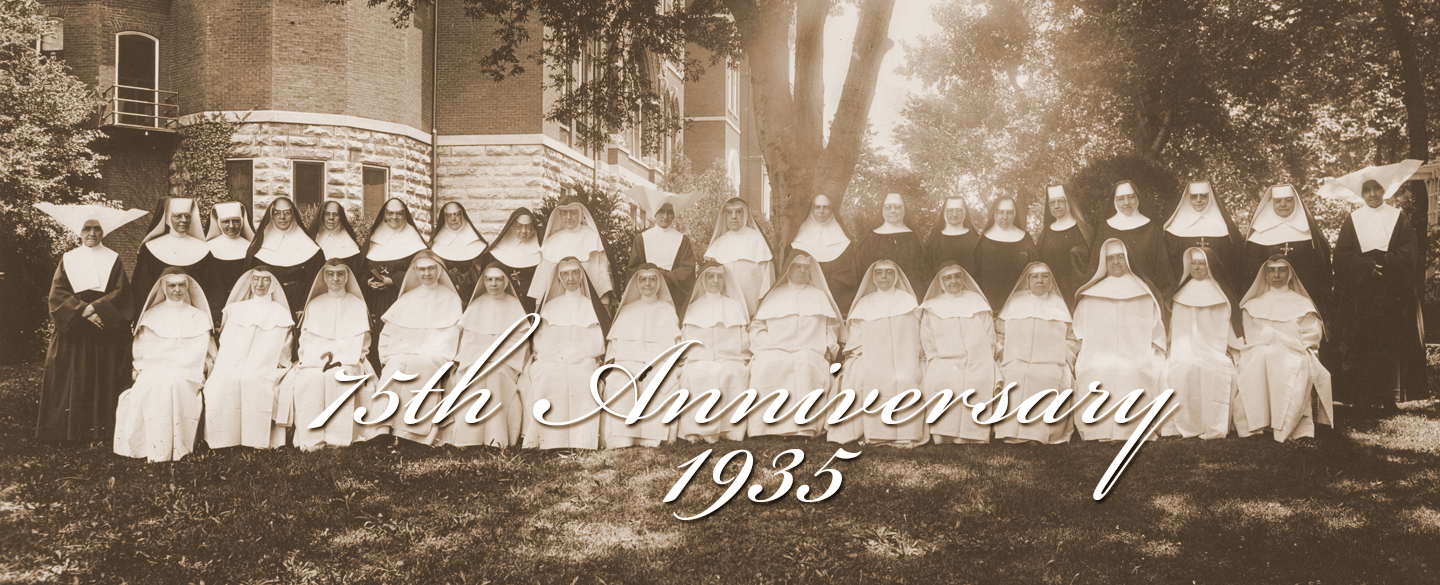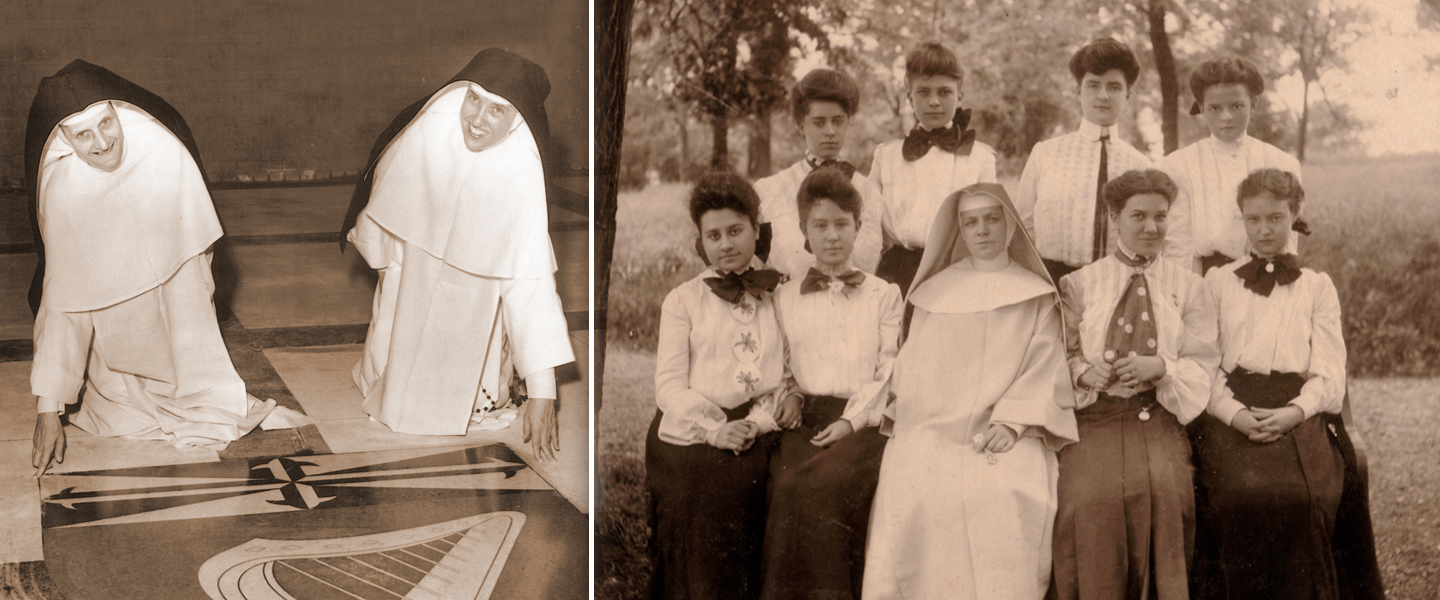
At last the St. Cecilia Community was able to stand alone. Her life had been one of long suffering. She had fought the good fight and had gained the victory. (Mother Frances Walsh, Annals of St. Cecilia Congregation, 1860-1881)

The twentieth century began with both prosperity and trial, as work in the apostolate flourished and new schools were added. Once again war and economic depression revisited the Sisters of St. Cecilia. The mark of the cross did not result in disaster, however, and was mitigated by the powerful presence of Divine Providence.
Dominican Affiliation
In 1913, the Congregation received formal affiliation with the Dominican Order. The decree was signed by the Master of the Order, at that time, Bl. Hyacinth Maria Cormier.
Teacher Education
In 1915, St. Cecilia was affiliated with the Catholic University of America for purposes of teacher education. This arrangement was made for the professional preparation of the sisters for the classroom. Called at the time St. Cecilia Normal School, it eventually was replaced by the community’s foundation of Aquinas College.
The Overbrook Property
In 1923, Mother Scholastica Breen, a native Nashvillian and graduate of St. Cecilia Academy, purchased a piece of property that was to figure providentially for the Congregation’s future. Since the present location of the Motherhouse was no longer considered a desirable location, thought was given to moving the Academy and Motherhouse to the Harding Road property. A deal was proposed and agreed upon but fell apart at the last minute. The citizens of Nashville were greatly opposed to the move, and it became clear that the Academy and Motherhouse were to remain at their present location. In 1926, an article in the Nashville Banner referred to the Harding Road property noting, “This is one of the most attractive localities and properties about Nashville and the Sisters announce a determination to establish a school there in keeping with the locality and the high standards of the best in music and art.”
Ten years passed and that “determination” expressed itself in the establishment of Overbrook School which opened in 1936 as an elementary school. While the sisters remained at the Motherhouse, the Academy moved to the property on Harding Road in 1957, and a few years later in 1961, Aquinas Junior College opened its doors.
Expansion
During this time period, the following schools were assumed by the Congregation:
- 1899: Assumption School in Nashville, Tennessee
- 1903: Winchester Academy in Winchester, Tennessee
- 1911: St. Joseph’s School in Memphis, Tennessee
- 1913: Immaculate Conception School in Monmouth, Illinois, the first school assumed outside of Tennessee
- 1916: Holy Name School in Nashville
- 1919: St. Joseph School in Jackson, Tennessee (The sisters assumed charge of St. Mary’s in Jackson, TN in 1889)
- 1923: St. Mary Star of the Sea School in Phoebus, Virginia
- 1927: St. Thomas Aquinas School in Cincinnati, Ohio; St. Ailbe’s in Chicago, Illinois
- 1935: St. Gertrude School in Cincinnati, Ohio
- 1937: St. Patrick School in McEwen, Tennessee
The Great Depression
The sisters who lived the challenges of this period of history acknowledge the privations and hardships suffered, but are quick to say that the challenges were endured with a characteristic religious spirit. Meat was infrequent and they rarely had coffee or desserts. Frugality was the order of the day but in the face of it all, that “St. Cecilia joy” was not compromised. The sister in the kitchen had the knack of “making something out of nothing.” Certainly, stories from the early days of the Order when the brethren were fed under miraculous circumstances took on special significance.
1935 Silver Jubilee
As St. Cecilia celebrated 75 years of existence, she numbered 115 sisters with over 2,000 pupils in 14 schools throughout Tennessee and in Virginia, Illinois and Ohio. In addition to the work in the Catholic School system, the sisters taught catechism in the mission churches of Tennessee where children did not have the benefit of a Catholic school. In her book, A Brief History of St. Cecilia, Sister Miriam Walsh commented on this silver jubilee with the statement, “Steady growth has marked [St. Cecilia Congregation’s] career…What the future has in store for her is among the secrets of God.”
Pontifical Status
In 1940, the Congregation received tentative approval of pontifical status. Formal status was granted by His Holiness Pope Pius XII in 1948.
Additional Schools of the Congregation
- 1949: St. John Vianney School in Gallatin, Tennessee
- 1950: St. Mary’s School in Oak Ridge, Tennessee
- 1953: St. Joseph School in Nashville, Tennessee
- 1954: Our Lady of Mount Carmel School in Newport News, VA; St. Paul School in Tullahoma, Tennessee
- 1956: St. Rose of Lima Academy in Birmingham, Alabama
- 1957: St. Henry School in Nashville, Tennessee
Through two World Wars and the Great Depression, the Dominican Sisters of Nashville lived the religious life with a characteristic consistency and a tangible spirit of sacrifice. They expanded in numbers of sisters and reached thousands of students with the opening of numerous schools. Simplicity, hospitality and devotion were the hallmarks of this small southern community. Next to her larger northern counterparts, the Congregation was outside of the mainstream, diminutive and not well-known. Since that time the Congregation has spoken on behalf of religious life and authentic renewal. In the years that followed the Second Vatican Council, the guidance of the Holy Spirit provided strong leadership and enabled St. Cecilia to respond to the call of Vatican II with a voice that was clear and unequivocal.


 Back
Back